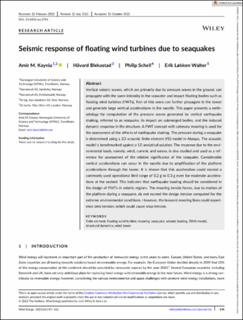| dc.description.abstract | Vertical seismic waves, which are primarily due to pressure waves in the ground, can propagate with the same intensity in the seawater and impact floating bodies such as floating wind turbines (FWTs). Part of this wave can further propagate in the tower and generate large vertical accelerations in the nacelle. This paper presents a methodology for computation of the pressure waves generated by vertical earthquake shaking, referred to as seaquake, its impact on submerged bodies, and the induced dynamic response in the structure. A FWT concept with catenary mooring is used for the assessment of the effects of earthquake shaking. The pressure during a seaquake is determined using a 2D acoustic finite element (FE) model in Abaqus. The acoustic model is benchmarked against a 1D analytical solution. The response due to the environmental loads, namely, wind, current, and waves, is also studied and used as a reference for assessment of the relative significance of the seaquake. Considerable vertical accelerations can occur in the nacelle due to amplification of the platform accelerations through the tower. It is shown that this acceleration could exceed a commonly used operational limit range of 0.2 g to 0.3 g even for moderate accelerations at the seabed. This indicates that earthquake loading should be considered in the design of FWTs in seismic regions. The mooring tensile forces, due to motion of the platform during a seaquake, do not exceed the design tension computed for the extreme environmental conditions. However, the leeward mooring lines could experience zero tension, which could cause snap tension. | en_US |

